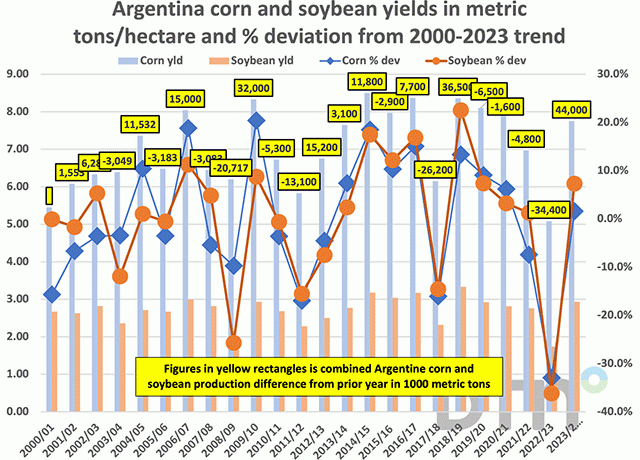Fundamentally Speaking
Markets Focused on Brazil, Argentina
Market attention rightfully is focused on Brazil, where it appears this week's rainfall may end up lighter than expected or needed in that country's northern and western regions with precipitation forecasts for next week also being scaled back.
Brazil has had to share the spotlight over the past few days, however, with its South American neighbor Argentina holding its runoff presidential election on Sunday where conservative party Javier Milei won. He plans to dollarize the economy and reportedly has support from the broader agricultural community with the market assumption being that a Milei victory would have a bearish influence on prices over time as farmers would presumably be more willing sellers under the new regime instead of holding and storing their crops as a currency/inflationary hedge.
P[L1] D[0x0] M[300x250] OOP[F] ADUNIT[] T[]
Needless to say, the main reason Milei won is the Argentine economy is a mess as prices were up 8.3% from the prior month, reaching an annual rate of 142.7%. Argentina has huge current account deficits and the only way to bridge those is through increased taxes and/or reduced government spending. Campaigning on that platform will hardly get you voted in for dog catcher, let alone elected to office. So, the only way out of this jam is for the central bank to start up the printing presses, creating more money and debasing even more the increasingly worthless value of their peso.
What you are left with is hyperinflation, which is where things stand leading up to the Dec. 20 change in government. We know that Argentina is an agricultural powerhouse but given the devastating drought of last year and its onerous grain and oilseed export taxes, dollars for its largest sources of revenue -- corn and soybeans -- have completely dried up, exacerbating the situation even more.
One can only hope the people of Argentina have elected a leader who can right the ship and also that Mother Nature blesses them this coming year with a bountiful harvest. In that regard, so far so good. For a while there's a lot of hand-wringing about dry and hot northern Brazil and too-wet southern Brazil, it appears Argentine row-crop season is off to one of its best starts in years. It should not be too hard to best the year-ago figures that were maybe the worst in that country's history.
Along these lines, this chart shows Argentina corn and soybean yields in metric tons/hectare on the left-hand axis versus yields percent deviation from their respective 2000-23 trend on the right-hand axis. Also reported in the yellow rectangles are the combined Argentine corn and soybean production difference from the prior year in 1,000 metric tons. This graphic only goes back to the 2000-01 season but the 2022-23 Argentine corn yield at 5.08 mt/ha was the lowest since 4.56 mt/ha back in 1996-97 and stunning 33% below the 2000-23 trend.
The soybean yield last season of 1.74 mt/ha was an even worse 36.1% below trend and the lowest since 1.63 mt/ha all the way back in the 1988-89 year. This cost the country over 34.0 million metric tons of combined corn and soybean output from the prior year -- much of it would have been exported for hard-needed currency.
(c) Copyright 2023 DTN, LLC. All rights reserved.






Comments
To comment, please Log In or Join our Community .